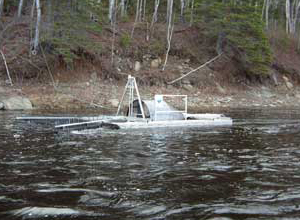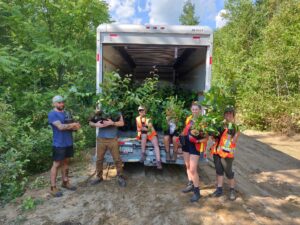If you would like to spend an interesting morning on the Nashwaak, we are looking for volunteers to spend a Saturday or Sunday morning in May assisting a Department of Fisheries and Oceans (DFO) technician in monitoring fish collected in the smolt wheel. The Nashwaak is used as the index river for all salmon streams downstream from the Mactaquac dam and the NWAI assists in this process. There are four shifts still available, May 11, 18, 25, 26. If you are interested, please contact Peter Salonius at petersalonius@hotmail.com or by telephone at 459-6663.
What it’s all about and what you will be expected to do

DFO operates a smolt wheel in the spring and an adult fish counting fence in the same location during the summer so that the numbers of salmon returning from the ocean can be compared to the smolt numbers that migrated to the ocean. This measurement provides an indication of marine survival.
The DFO tech on duty for your morning will contact you by telephone a day or so before to set a time and place to meet. The tech will often pick you up on the way out to the smolt wheel which is located just downstream from Durham Bridge, and then drop you back at your home when the work is completed. You will need to wear waterproof footwear – high rubber boots or waders if you have them – and a life jacket.
You will travel by motor boat a short distance upriver to the smolt wheel which is guy-wired in the main current. The wheels look like cement mixers with the big end facing upstream — the current makes the wheel rotate and migrating fish are gently directed by the wheel’s rotation into a holding well. The boat will be tied to the deck (which is like a floating dock) and will do most of the operation (clearing debris from the wheel and fish well, netting the fish and depositing them in buckets in the boat). The tech will need you to tally the salmon smolts as WILD or HATCHERY ORIGIN in groups of five, as well as mark down other species and their sizes on waterproof paper in a log book.
Once back on shore, retained fish in buckets will be anesthetized, measured, weighed and have a scale sample removed for later analysis to determine how many years they have been in the river since hatching from the egg – here again you will be making entries in the log book and marking lengths and weights on sample envelopes into which the glass slides with the scales are deposited. Plastic tags will also be attached to a certain number of the fish which is an operation requiring both you and the tech.
At the end of the morning, the tagged fish will be taken several kilometers upstream and placed back in the river. The proportion of these fish that are recaptured on subsequent days will indicate how much of the total population is being captured by the wheel(s) so that the total number of juveniles migrating toward the ocean can be estimated at the end of the season.
This is a unique experience so we hope you’ll be interested in giving it a try!

